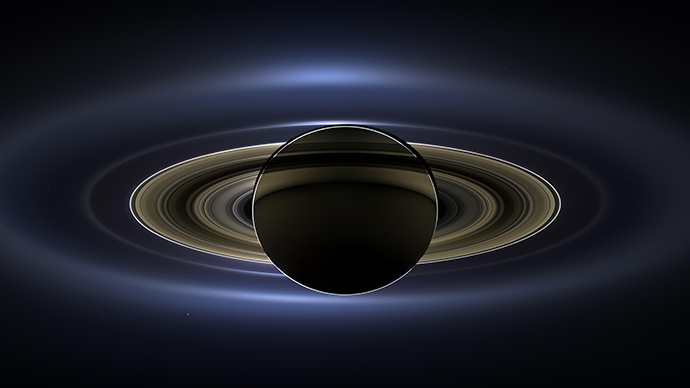Amazing details of Saturn & its moons captured by NASA

The hydrocarbon seas and potential for life on Saturn’s moon Titan get so much attention that it’s easy to forget the 61 others that surround the planet. NASA shifted that focus this week, producing the most detailed images of Saturn’s icy moons to date.
NASA’s Cassini spacecraft has been studying Saturn and its moons for a decade now, routinely delivering stunning images of the second largest planet in our solar system. One of its noteworthy achievements is that it is now shedding a lot more light on six moons that were once shrouded in mystery.
When NASA’s Voyager spacecraft flew by moons like Mimas, Enceladus, Tethys, Dione, Rhea, and Iapetus back in the 1980s, it sent back landmark images that were nevertheless fuzzy, incomplete, and hard to make out. Now, Cassini has plugged the holes – with bursts of color, no less – and delivered stunning new images of these icy satellites.
Here is a before/after shot of Mimas showcasing the differences between Voyager's image (left) and Cassini's (right).

"The most obvious [discoveries] are differences in color and brightness between the two hemispheres of Tethys, Dione and Rhea,” wrote Preston Dyches of NASA’s Jet Propulsion Laboratory. “The dark reddish colors on the moons' trailing hemispheres are due to alteration by charged particles and radiation in Saturn's magnetosphere.”
“Except for Mimas and Iapetus, the blander leading hemispheres of these moons – that is, the sides that always face forward as the moons orbit Saturn – are all coated with icy dust from Saturn's E-ring, formed from tiny particles erupting from the south pole of Enceladus."

You can view the rest of the images here. Impressively, however, these aren’t the only photographs of Saturn and its moons making headlines this week.
In addition to these new color maps, one Croatian programmer has taken it upon himself to enhance dozens of Cassini images depicting Saturn, Titan, and other moons. Gordon Ugarkovic said he was “somewhat underwhelmed by the frequency the Cassini Imaging Team releases color composites,” noting that the team often releases gray scales even when it doesn’t have to.
Instead of waiting, Ugarkovic updated and added color himself, posting the images on Flickr. In one image, Ugarkovic highlighted the point where Titan’s thick atmosphere gives way to space, depicting it in a light and fading blue while the moon Dione rests in the foreground.

Another image, meanwhile, reveals stunning details of the surface of Enceladus. The moon is believed to be home to vast oceans underneath the surface.

You can view even more images here.












